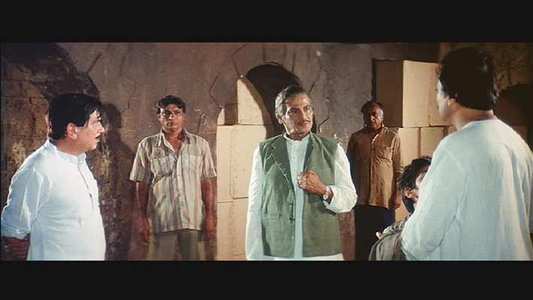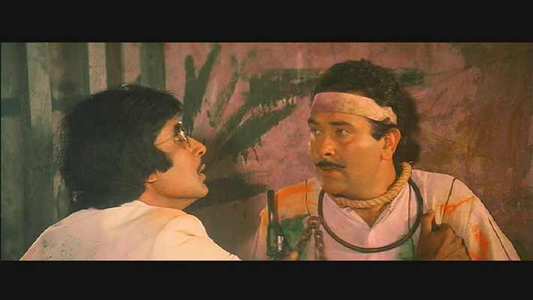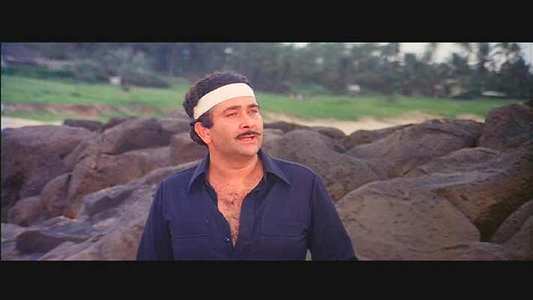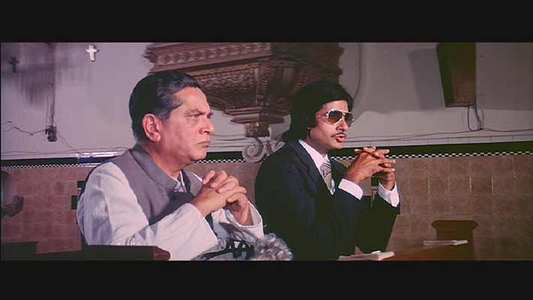Review of Pukar
Introduction
A young boy called Ramdas is on the run from the Portuguese police with his father and Purandare (Dr Sheeram Lagoo). However in the midst of the mayhem Ramdas runs in another direction, and the police carries on running after the father and Purandare. The police then fire their pistols at the father who is badly wounded, unable to continue. The father asks Purandare to shoot him so the police would never know about the whereabouts of the group. Purandare reluctantly agrees to do this for the sake of what the two fights for.
Ramdas finds the two and sees the death of his patriotic father in the hands of the Purandare. Not realising what actually took place Ramdas runs away from both Purandare and the police. Ramdas then goes into hiding at his father’s closest friend Daya Anand (Om Shivpuri) and his wife house. Both hide the boy within their compound. The police then raid their house and beats up the couple to see if Ramdas has come there. The next day when Ramdas sees Purandare coming he runs away, and Daya Anand learns of the death of his friend from Purandare.
Ramdas, who is haunted by the image of his father being shot, grows up to hate what the revolutionists represent. Ramdas changes his name and ideals to become Ronnie and slowly Ronnie (Amitabh Bachchan) begins to work in the criminal world supplying guns and gold. Ronnie soon becomes the top criminal in Goa and gains respect within the elite and high class Portuguese people who have power over Goa. But Ronnie’s girlfriend Julie (Zeenat Aman) thinks differently and wishes for freedom like many Indians.
In her life enters the new revolutionist Shekar (Randhir Kapoor), who all Indians of Goa supports and who Julie begins to help, using finances from Ronnie who is unaware of all of this. But when Ronnie finds out he becomes a traitor to the Indians and places a trap for Shekar. With the help of the Portuguese officials he is caught, condemned, and to be hanged.
In the midst of his personal celebration Ronnie soon realises that Shekar’s parents are the same couple who save him from the police when he was a boy. He then begins to think about his father’s death and soon realises that his father must have wanted to die so that the police would know anything about the revolutionary group. Knowing what he should have been and what he has become forces Ronnie to once again become Ramdas whose mission is to save Shekar…and with him fight for freedom for the people of Goa.
DEI are known for their excellent work on producing DVD’s and restoring Indian classics. An example of their work can be seen on many titles like Deewar, Trishul, Shor & even Bajrangbali. They have received praises and criticisms for their hard efforts, but are in general regarded by the public as quality conscious. Personally I have always favoured their work, but I feel that DEI still need to learn much about the public and how to target a wider audience as their marketing is not as good as it should be, and many audiences are not noticing them or their products. This could be why the company is not yet in the big league. I say all that because the title I am about to review is their best work EVER on an older title yet many won’t purchase it, and from the box cover and no marketing strategy you can see why.

Video
The film was shot on a large canvas that has never been seen before fully on a home format, now for the first time DEI have presented the film in its original aspect ratio of 2.40:1 in anamorphic. The film has been taken from an interpostive print which shows no signs of any decay, wear or tear or even green fungus normally seen on older Indian films. The odd little white and black specks appear but you really have to be sharp eyed to spot them. The result is quite something, it looks as fresh as a new title released by DEI. Only the archive footage used in the film’s climax has lots of wear and tear signs but the film originally had that look and nothing can be done about them.
The 35mm print negative source used for this DVD is in excellent condition, and thankfully the producer must have kept the original print in a decent place other then his garage or basement! The DVD appeared to have no encoding problems like compression artefacts, or edge enhancement while shimmering and moiré effects only came in a couple of scenes.
Picture detail was strong and out of this world! It has made its mark on my mind as it showed just how good even an Indian film 20 years back can look. It even gave viewing this picture a new lease of life, never did I think I was watching an older film. Even my girlfriend sat and watched, and she hates Indian films. When she found out the film was as old as me she was stunned and with amazement said “never”. I feel that was the best complement DEI could have on this title.
The picture details were reflected by the excellent sharpness that conveyed information with so much ease on the eye. Never did my eye have to strain, as it was quite comfortable to view as all could be seen.
A couple of scenes had brown hues within the frame, but they never did hinder viewing upon the rest of the film, which had the colourful Eastman look. The clear blue sky’s in the song “Samundar” looks as radiant, while the red bloody climax looks as voracious. The vibrant colours indeed leave an impression that is positive.
The dark details are also very well defined as it is never difficult to see what occurs in poorly lit, or dark scenes. The beginning of the film opens with a long night sequences and was shot with poor lighting. Yet just as a person could see it on cinema, the same can be said for this DVD version. Never do you have to tweak the picture setting to see what is going on, it is clearly encoded and projected with accuracy. Contrast details are also very dimensional.

Audio
The Dolby Digital Hindi audio on this DVD is presented in its original mono soundtrack, and is the best possible manner to present the film as it was originally shot like that. Dialogues and music are clear to the ears without much sound distortion.

Features
The menus and box design is a disappointment, but since the original photocells the film is missing DEI had to resort to capturing clips form the 35mm print and doing this they know that it won’t look as good on print (paper) format. What they could have done was create a new image of the film with just icons, and the film logo. You don’t really need pictures of the actors. DVD’s boxes like Akira and Unbreakable (Region One) are good examples of what I mean.
The only extra comes in the format of the English subtitles, which covers everything said and sung. Also you can watch all the songs in one go without the need to skip chapters, but a small prince is place for that feature, a quick 0.5-sec pause after each song is finished, while watch the whole feature film. But the DVD was done a while back when DEI was doing this feature on all their titles. Now they have abandoned this feature presently but some older titles to be released will still have it.

Conclusion
The film has an interesting concept in its plot and screenplay, which is never looked upon in more detail, making it a surface viewing point. It would have been interesting to further elaborate on the politics of how the Portuguese government and people worked, but we are just treated to a bias viewpoint of the era which shows anyone against the Indian’s as bad and Indian’s as good. This makes characterisation rather weak and predictable but this was, and still is, the norm for Indian cinema which continues to live upto many audience’s expectations. Successful (and controversial) films like Gadar (2001), Lagaan (2001) and Border (1998) have proved that.
Still the film makes for excellent viewing for Amitabh Bachchan fans and for those looking for a film which shows how an Indian cinema worked during the early 1980’s. The film shows at times high technical values, which still stands up to this day and although some fights scenes overused repeated shots, it was a Bachchan film which justifies its use. If anything was bad it was the use of old archive footage at the end of the climax that was out of place and not as satisfying as the main bloody climax, in which Amitabh Bachchan is in his most bloodiest, before Agneepath (1990) came along.
Speaking of Amitabh Bachchan I must talk a bit about his performance in this film which showed his amazing presence. In Pukar he remains quiet, and is not the “Angry Young Man” he was in his other action films. However for the majority of the time he is the bad guy who gets patriots caught and killed, but we don’t mind because it is Bachchan and we know he is mistaken too! Imaging Sunny Deol playing a Pakistani officer in Border, would we still root for him the way we did when he was the Indian Solider? The Big B has screen presence in this film and his dark side is touch upon and is the main highlight of this film as fans still find this aspect both interesting & satisfying, in a strange way.
The music is another aspect of the film that has become memorable and still is melodious in the current days of A.R Rahman, Bally Sagoo and even Nitin Swahey. R.D Burman, who sings most songs in this film, has created wonderful tunes like “Bachke Rakna Re”, “Mar Jaange”, & my favourite “Samundar Mein Nahake”. All songs have elements of Portuguese rhythm to fit in with the rest of the film, and the way they are shot are also very special.
I’m sure many will remember the Samundar song and Zeenat Aman in her white provocative dress splashing away in the sea. This image has become just as important as the introductory scene of Honey Ryder in Dr.No (1966) when she walks from the sea. I do enjoy the rough unsound voice of R.D Burman in these songs as they do the character of Ronnie in a fitting way, so good move R.D Burman! Amitabh Bachchan also sings a song in this film (“Tu Maike Mat Jayo”), which in its own right has become a cult like this film, but its not on the scale the other songs and feels a little left out when this film is ever thought about.
But with the good things comes the bad namely in the direction, which seems poor and rushed at times. Also Randhir Kapoor and Tina Mumin seemed to have been miscast, as they never fulfil the demands of the screenplay because their performance is simply quite dry. I assume they were cast as Randhir Kapoor was a close friend of the director, who had given him one of his biggest hit ever Jawani Diwani (1972), and Tina Mumin was one of the biggest leading female actor in that year. Supporting cast is on hand to at least make us enjoy the performances within this film more. While the two leading casts Big B and Zeenat Aman never disappoint.
Overall this is one of Rose Movies (banner) best movie, and their darkest film before Indrajeet (1990) came out. It wasn’t exactly a blockbuster, but like all Big B films it has become a classic and is well remembered in the minds of his fans.
DEI once again shows us just what can be done on an older title. This DVD even give newly released films on DVD’s like Pyaar Ishq Aur Mohabaat, Mujhe Kuch Kehna Hain & Aks a run for their money. A must purchase for all Indian DVD fans!
Your Opinions and Comments
Be the first to post a comment!